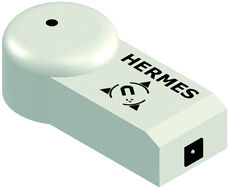H.E.R.M.E.S: rapid blood-plasma separation at the point-of-need†
Abstract
The global healthcare landscape is experiencing increasing demand for CLIA-waived testing facilities that offer diagnostic capabilities at lower costs and greater convenience than traditional laboratory testing. While several new diagnostic tools have emerged to fulfill testing requirements in these environments, centrifuges have been stymied from transitioning to the point-of-need as the US Food and Drug Administration (FDA) classifies them as mostly unsuitable for use in CLIA-waived environments. Limitations in sample processing capabilities adversely affects the ability for CLIA-waived testing environments to offer a broad testing portfolio and present-day diagnostics are bottlenecked by the requirement for centrifugation. Here we present the High Efficiency Rapid Magnetic Erythrocyte Separator (H.E.R.M.E.S), a rapid low-cost technology that can perform the separation of red blood cells from plasma at a fraction of the time and cost of that of a centrifuge. We demonstrate that H.E.R.M.E.S is able to obtain highly-pure plasma (greater than 99.9% purity) at less than 2 minutes per test. Further, we detail that it is an easy-to-use method capable of being incorporated with present-day diagnostic technologies and prove that it is superior to existing alternatives to centrifugation by validation with a ferritin lateral flow test. H.E.R.M.E.S is a suitable alternative for centrifugation in point-of-need settings and aims to facilitate the decentralization of commercial blood testing.


 Please wait while we load your content...
Please wait while we load your content...
